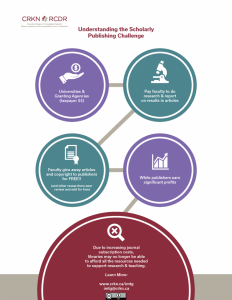1.4 The Role of the Academic Library

In many ways, academic libraries are well positioned to see the effects of publisher consolidation first hand, as they remain the primary purchaser of scholarly content.
Since the 1990’s academic libraries have largely transitioned their purchasing of academic content to “big deals”, under which publishers bundle together hundreds or even thousands of journal titles into packages.
When this model emerged it offered substantial value for libraries as the per-title cost of journals went down. “Following this new model, size of serial collections in academic libraries increased almost fivefold from 1986 to 2011”.
While this new purchasing model allowed libraries to rapidly increase their collections, it also resulted in increases in collection expenditures and decreases in the value of these investments, as researchers and students still largely read and cited only a fraction of the titles held in library collections.
Transitioning away from the big deal
In more recent years, the thinking around the value of the big deal has slowly changed as libraries have come to terms with the fact that it is no longer possible, nor necessary, to keep up with the every increasing level of scholarly output. For decades now, publishers have been increasing the costs of journal subscription deals at rates that outpace inflation. As a result, subscriptions become more expensive every year. This has resulted in what is often referred to as the “serials crisis”, whereby academic libraries are increasingly unable to keep up with the rising cost of subscriptions.
In the last few years frustration over the rising cost of subscriptions, paired with the growing availability of open access research has led many libraries to either cancel their big deal subscriptions or work with publishers to draft new types of licenses that incorporate open access principles and offsets. In a 2020 survey of academic library directors, half indicated that they will likely cancel a journal package in the next five years.
While big deal cancellations are still news-worthy occurrences, there is good evidence to suggest that they will become more commonplace in the future. Schools that have yet to make the difficult decision to cancel are looking to trailblazers like the University of California, which recently cancelled its subscription with Elsevier after a long and ultimately unsuccessful renegotiation. The UC system was able to marshal faculty support for their cause, but many schools are still unsure if their faculty and students will support a decision to cancel a large subscription package.
Scenario – Breaking up with the ‘big deal’
Let’s consider this scenario: The library has just informed your department that due to budget constraints they plan on cancelling a large subscription package that includes many of the journals you regularly read and cite. The library will be purchasing individual subscriptions to a much smaller number of journals and while a few of the key journals you rely on are on the list, others are not.
- What would be your initial response to the library’s decision?
- What should the library do and who should they consult before finalizing their new approach?
Dig Deeper
To learn more about the cancellation of big deals, review:
SPARC’s Big Deal Cancellation Tracker
Anderson, Rick. (2017). When the Wolf Finally Arrives: Big Deal Cancellations in North American Libraries (comments on this post highlight the ongoing debate).
